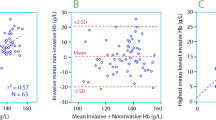Abstract. Acute normovolemic hemodilution entails removal of blood from a patient either immediately before or shortly after induction of anesthesia and simultaneous replacement with cell-free fluid. Nowadays, because of their predictable volume effects, the synthetic colloids (6% dextran 60/70, 6% hydroxyethyl starch 200,000) are preferred as volume substitutes; albumin should be avoided because of its high cost. Hemodilution has experienced a renaissance in recent years, mainly due to the evolving discussion of legal aspects, immunologic changes, viral infections, and a potentially higher cancer recurrence rate associated with the transfusion of homologous blood. Hemodilution should be considered for elective surgical patients free of contraindications and presenting with an initial hemoglobin concentration ≥ 12 g/dl and an anticipated blood loss of ≥ 1500 ml. The efficacy of this method (judged by the need to give homologous blood transfusion) depends on the preoperative (initial) hematocrit, the target hematocrit (to which hemodilution is performed), and the preset intra- and postoperative transfusion trigger. In the past, data from clinical trials showed that in healthy subjects a target hematocrit of 20% to 25% (hemoglobin 7.0–8.0 g/dl) is feasible and safe for the patient. The lower the target hematocrit accepted, the more extensive is the monitoring required: Intraoperative target hemoglobin concentrations of 5.0 g/dl and less have been tolerated by surgical patients without adverse effects. The safety and efficacy of acute normovolemic hemodilution in terms of reducing homologous blood transfusion requirements has been demonstrated in various clinical studies. Hemodilution therefore is regarded an integral part of programs aimed at reducing the need for homologous blood and can thus be successfully combined with preoperative autologous blood deposition, intraoperative blood salvage, and carefully adjusted surgical techniques. Hemodilution is feasible and relatively cost-effective, and it minimizes adverse effects associated with transfusion of homologous blood, particularly transmission of viral diseases, immunosuppression, and infectious complications.
Similar content being viewed by others
Author information
Authors and Affiliations
Rights and permissions
About this article
Cite this article
Kreimeier, U., Messmer, K. Hemodilution in Clinical Surgery: State of the Art 1996. World J. Surg. 20, 1208–1217 (1996). https://doi.org/10.1007/s002689900184
Issue Date:
DOI: https://doi.org/10.1007/s002689900184




